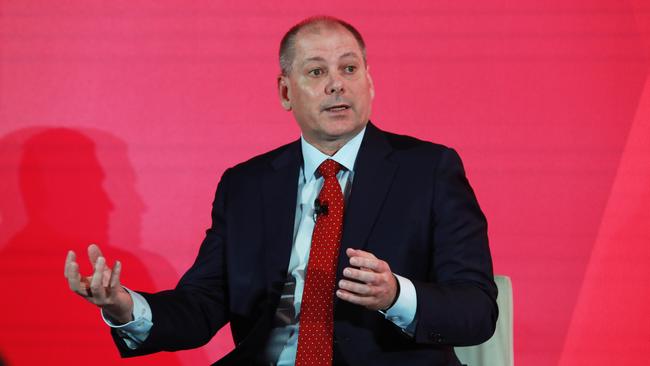I watch unemployment more than house prices: Westpac CEO
The bank’s boss is adamant a sharp decline in home values will only pose a material risk to the economy and the banking sector if it is accompanied by a large spike in the jobless rate.

Business
Don't miss out on the headlines from Business. Followed categories will be added to My News.
Westpac’s chief executive Peter King is adamant a sharp decline in house prices will only pose a material risk to the economy and the banking sector if it is accompanied by a large spike in the jobless rate.
While the bank is anticipating a 16 per cent slump in prices from their peak by December next year, Mr King said it was rising unemployment amid slowing growth that would be a greater threat to the economy and financial sector.
“I watch unemployment more than house prices,” he said in an interview after delivering a dip in Westpac annual profits to $5.28bn. “For us to lose money in mortgages it’s normally someone loses their job, someone gets sick, or they get divorced … maybe income doesn’t keep pace with expenses but we assessed all of the mortgages with interest rate buffers.”
Westpac expects official rates to peak at about 3.85 per cent, from 2.85 per cent currently, and unemployment to rise to 4.5 per cent next year. Rates have climbed in seven rapid moves by the Reserve Bank this year, prompting concerns about how borrowers will manage repayments and how much the economy will slow.
Mr King said despite the aggressive rate moves consumers, borrowers and businesses were so far faring well, keeping a lid on any loan losses.
But he also admitted there were long lead times on passing through rate hikes, saying Westpac was still processing the last three rises into monthly loan repayments. “Credit quality in its aggregate sense, most of the metrics … are now back at pre-Covid levels,” Mr King said.
He highlighted the biggest challenge for policymakers was to “contain the high inflation psychology” taking hold across the economy. “In Australia, consumer spending is resilient but as higher rates bite, we expect the heat to come out of the economy and inflation pressures to ease. Small business is one sector we are watching closely as consumption slows,” Mr King said.
He noted while the October budget included distinct initiatives on the renewable energy transition and to lift the supply of affordable housing, business would need to continue to work closely with governments on those topics.
“The first priority is actually energy transition so we’ve got to get the investment into the electricity grid to get it less reliant on fossil fuels and continue its reliability,” Mr King said. “In regional Australia often one of the issues is there’s not enough housing for people … affordable housing is critical.”
But after sealing a new enterprise agreement via a direct staff vote last week, Mr King said Westpac wasn’t a supporter of multi-employer bargaining as is being proposed by the government in an industrial relations bill. “We are watching them very closely. We’re not sure we would like broadbased industry enterprise agreements so we’re looking closely at whatever changes might come through parliament,” he added.
Westpac on Monday blamed a rampant inflationary climate, rising wages and regulatory spending for moving away from its 2024 cost-cutting target, as the bank reported a decline in annual profit on lower net interest income.
The bank’s cash profit fell 1 per cent to $5.28bn for the 12 months ended September 30, compared to the year earlier period. It declared a final fully-franked dividend of 64c per share, following an interim payment of 61c per share. Annual net interest income fell to $16.6bn, from $16.7bn in the prior year, and non-interest income – which largely reflects fees – tumbled 45 per cent.
Westpac’s annual cash profit was dented by a $1.1bn previously flagged loss on the sale of its life insurance division to TAL Dai-ichi Life Australia. The bank’s statutory annual net profit rose 4 per cent to $5.69bn and it said core earnings, excluding notable items, climbed 12 per cent.
Westpac’s shares tumbled 3.9 per cent to $23.19 on Monday as investors digested the result. ANZ – which traded without its latest dividend – dropped 4.6 per cent and National Australia Bank 1.2 per cent, while Commonwealth Bank bucked the trend and edged up slightly.
Ethical Partners Funds Management investment director Nathan Parkin said shareholders were concerned about Westpac’s relative net interest margin expansion and whether it would meet its revised cost target. “What I find a bit surprising is that they kept a cost target at all. All their competitors now haven’t got an absolute dollar cost they’ve just got some zone … it just leaves them a bit open to not meeting that again,” he added.
Westpac joined several of its major rivals in shifting away from a cost reduction target, but unlike its peers did not abandon the metric. Westpac said the prior $8bn cost target by its financial year 2024 would increase to $8.6bn over the same time frame.
The bank’s net interest margin – what it earns on loans less funding and other costs – rose five basis points to 1.90 per cent at the end of its latter half, as the rate hiking cycle fed through. The net interest margin is a key profitability measure for banks and is boosted by lenders passing on rate rises to mortgages and loans at a faster pace than they increase rates to depositors.
CLSA analyst Ed Henning noted Westpac’s underlying exit margin for September rose five basis point compared to the latter half‘s average, but said that compared poorly to ANZ which saw a 12 basis point rise.
Barrenjoey analysts said: “The exit (net interest margin) was a bit lower than expected … Given the recent (share price) rally, we expect the share price reaction to be soft.”
NAB rounds out the major bank reporting season when it reports profits on Wednesday.
Westpac managed to slice operating expenses by 19 per cent in the 12 months ended September 30, as it reduced third-party services, staff numbers and merged branches. Average full-time equivalent employee numbers declined 5 per cent and the bank said that rate of decline would continue in 2023. Excluding notable items expenses fell 7 per cent.
More Coverage
Originally published as I watch unemployment more than house prices: Westpac CEO




